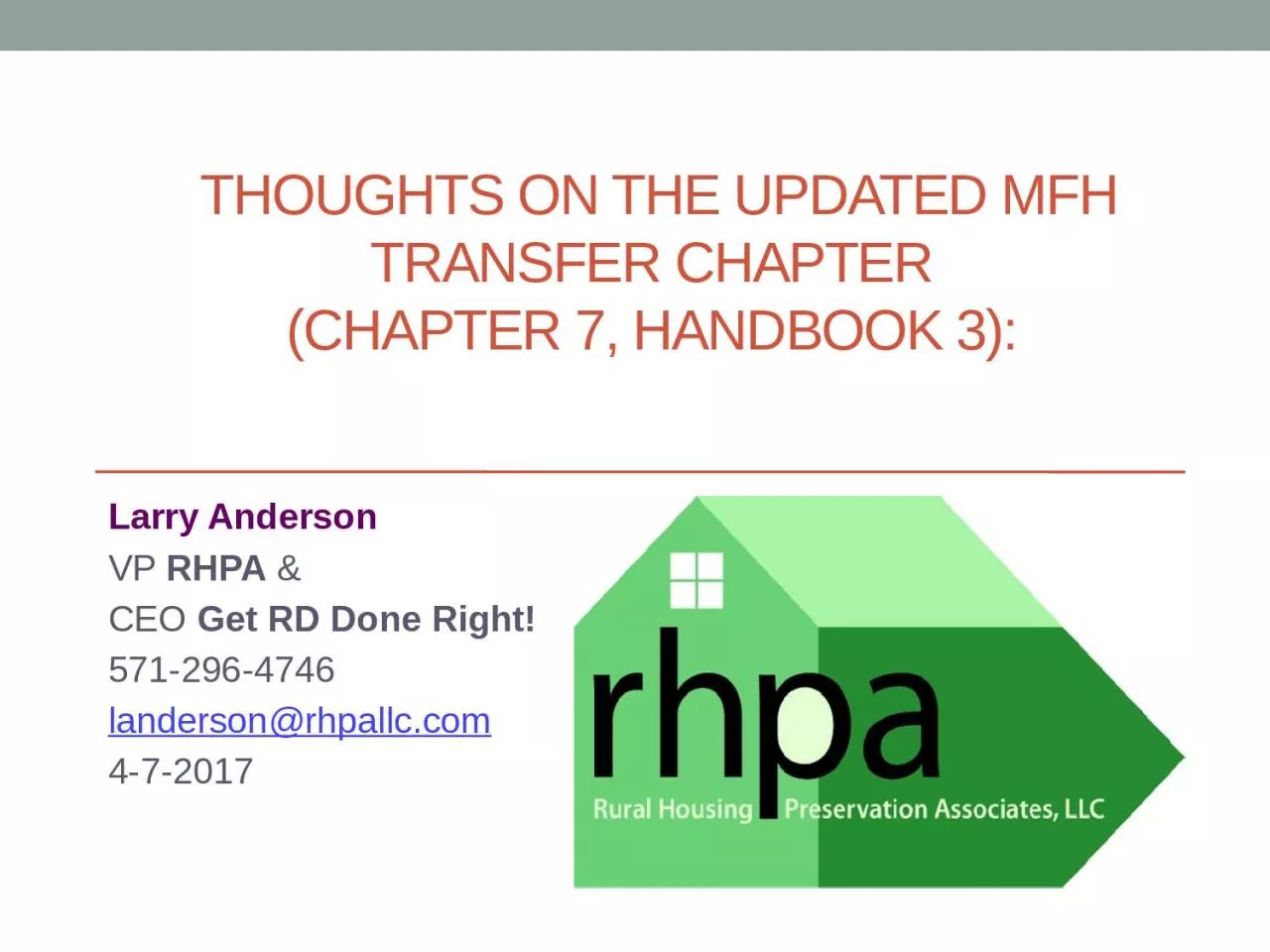

Chapter 7 Handbook 3 Larry Anderson VP RHPA amp CEO Get RD Done Right 5712964746 landersonrhpallccom 472017 RDs Initial Revitalization Strategy Components of all deals ID: 932201
Download Presentation The PPT/PDF document "THOUGHTS on THE UPDATED MFH TRANSFER CHA..." is the property of its rightful owner. Permission is granted to download and print the materials on this web site for personal, non-commercial use only, and to display it on your personal computer provided you do not modify the materials and that you retain all copyright notices contained in the materials. By downloading content from our website, you accept the terms of this agreement.
Slide1
THOUGHTS on THE UPDATED MFH TRANSFER CHAPTER (Chapter 7, Handbook 3):
Larry AndersonVP RHPA & CEO Get RD Done Right!571-296-4746landerson@rhpallc.com4-7-2017
Slide2RD’s Initial Revitalization Strategy
Components of all dealsProject is needed in market
Post transaction owner is eligibleBasic Feasibility Thresholds
CNA to determine capital needs, timing and funding
Underwriting to determine feasibility and tools
SUSTAINABLE RENTS = SUSTAINABLE PROPERTIES!CNA needs - O&M - operating cushion – vacancy - accounts current
Slide3RD’s Initial Revitalization Strategy
Basic Feasibility Thresholds (continued)Seller payments and increased RTO is market based
Market value for equity when hard loan part of dealCRCU limit for equity payment and increased RTO
CRCU test before any MPR tools
Consider impact on tenants
Long Term Commitment – RD’s RA funding/Owner
’
s RU
P
Slide4New Underwriting Principles (Chpt 7 Handbook 3)
Project is needed in communityPost transaction owner is eligibleCapital and accessibility needs addressed
Post transaction rents will not displace current tenantsRents don’t exceed the lesser of CRCU or restricted rents
RD recognized equity must be supported by an appraisal and underwriting
Slide5New Underwriting Principles (Chpt 7 Handbook 3)
Equity defined by market value RD approved appraisalIf no equity an “exit incentive” (IE) may be paid under certain conditionsEither Seller Equity or EI – not both
RD MFH HQ approves any equity amounts and RTO
Third party loans and guarantees encouraged
Rents don’t exceed the lesser of CRCU or restricted rents
New RTO to be calculated at the time of transfer
Slide6New TRANSFER Thresholds (Chpt 7 Handbook 3)
Post transfer rents – lesser of HOME (if used), LIHTC or CRCURents must cash flow in proposed operations - Vacancy and contingency at 5%, NOI to meet 1.15 DSCR or higher 3
rd party DSCRVacancy/Bad debt loss – max 10% for > 16 units, 15% for < 16, and should be most recent 3 year plus 2%
Operating expenses – No more than 10% reduction from 3 year avg.
General operating account minimum requirement – 20% of operations
Tenant protection – Owner must protect all non-RA tenants from rent increase caused by transaction
Slide7New TRANSFER Thresholds (Chpt 7 Handbook 3)
CNA funding and reserve deposit – Greater of CNA or third party lender required deposits. Positive at end of 20 yearsNew loans for RD Section 515 RRH - eligible purposes (not developer fee or equity)
Debt service coverage ration (DSCR) – Trend 2% for revenue, 3% for expenses, DSCR 1.15 for years 1-3, 1.1 for 4-5, and 1.0 >5.
Loan to Value – All rehab must be within “prospective as-improved Security value including favorable financing
Loan Terms of third party debt – No balloons of 3
rd party debt before RD loans, unless 3rd party agrees to keep rents affordable
Sources and uses must balance – includes health, safety, accessibility
Development shortfalls must be from non-project sources.
Slide8RD Preliminary Assessment Tool (PAT)
Standard underwriting format used for all RD MFH transactions (other funders have their versions) includes:General Information – Size and location of project, number of units, original funding, current account and loan balances
Sources and Uses – Sources for all transactional funding and detailed projected hard and soft uses and contingencies
Reserve Sizing – Based on a CNA, 20 years of capital spending and funding to track long term capital uses and funding availability
Rents and Operations – Current and projected rents and incomes as well as operational expenses, based on most recent 3 years
Pro Forma - 15 year trending examines inflation’s effect on project income and expenses and project’s ability to maintain NOI and DCR Review Tool – Quick look to see if underwriting standards are met.
Slide9Key issue with transfers –
How does the resource pie get divided?Balanced deal$60 K per unitRehab cost ($20K)Seller payment ($20K)
Soft costs ($20K)CRCU ($600)
Slide10Poor market –
How does the pie get divided?Low sales price$40 K per unitRehab cost ($20K)Seller payment ($0?)
Soft costs ($20K)CRCU ($400)
Slide11Revitalization Battleground – Sizing the split:
rehab, seller and soft costs
Sustainable rents –
What does CRCU support?
Rehab
upfront/spread out
Seller payment
loan or cash?
Soft costs
loan/cash
upfront/deferred
Slide12What’s missing from the new transfer handbook?
Policies to provide preservation to projects that have no “equity” or “IE,” but are still desperately needed in the community they serve.New tools could include the following that allow for:
GP purchaseLP purchase
Split (tiered) rents
Servicing RA units
Targeted MPR funding toolsGifting processTurning in failing properties without penalties
Allowing above CRCU rents to continue